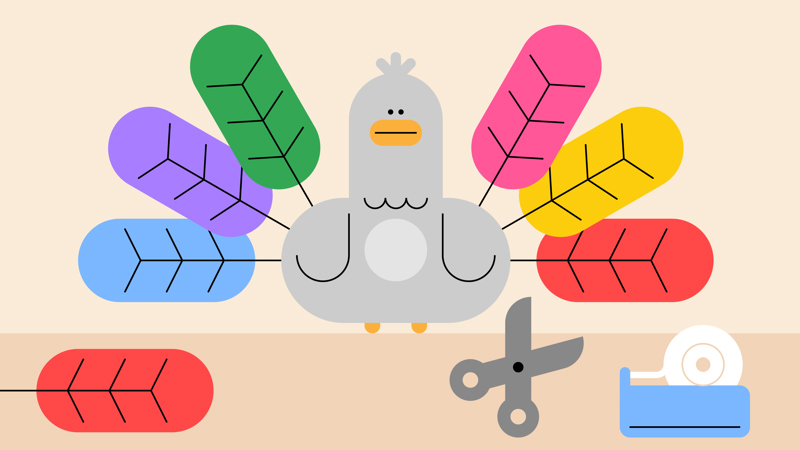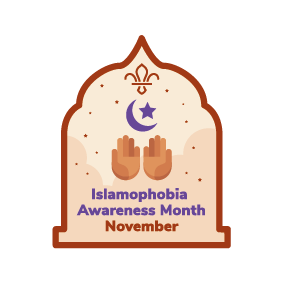
Faith feathers
You’ll need
- A4 paper
- Coloured pens or pencils
- Scissors
- Glue sticks
- Card (optional)
Scouts is open to everyone. We don’t identify exclusively with one faith, and we welcome people of all faiths and of none.
We know it’s important for people to learn about each other, including understanding different faiths and beliefs. Scouts always respects people’s beliefs, faiths and cultures, and everyone should be open to learn.
As an inclusive and values based movement, we support our members to engage and learn about different faiths and beliefs in an exciting and meaningful way, even if they don’t have a faith themselves.
Celebrating and understanding differences, including differences in faiths and beliefs, is an important part of our Scout values, which are:
- Integrity: We act with integrity; we are honest, trustworthy and loyal.
- Respect: We have self-respect and respect for others.
- Care: We support others and take care of the world in which we live.
- Belief: We explore our faiths, beliefs and attitudes.
- Co-operation: We make a positive difference; we co-operate with others and make friends.
Our value of Belief and its exploration helps Scouts to learn from other faiths and beliefs. This encourages them to develop or build their personal beliefs and understand their shared values, whether faith-based on not.
We know that learning about faiths, beliefs and different attitudes can help to break down barriers, helps us all to recognise what we have in common, and teaches us to value and respect other people. It also helps us to build up respect, acceptance and knowledge for each other, leading to a more co-operative and inclusive society.
In our diverse society, people can sometimes feel cautious talking about this sensitive subject. However, it's important that Scouts offers young people safe, exciting and open spaces to explore faiths and beliefs. They should be able to engage in personal reflection, as they question and develop their opinions and understanding of the world around them.
Making time for personal reflection and developing our beliefs means exploring the places, people, communities, celebrations or stories which hold meaning for us, and it may not necessarily mean exploring a faith.
For example, someone’s shared values may be their Scout Values and that person may choose to reflect on them at important times, such as when they make their Promise. Others may choose to reflect at certain times of the year, such as a faith-based festival, birthdays, meaningful events or at New Year. Some people may still celebrate events, such as Christmas, but use it as a time to celebrate family, friends and loved ones, as well as for charity and giving.
Discover more about Faiths and Beliefs in Scouts.
Before you begin
- Use the safety checklist to help you plan and risk assess your activity. Take a look at our guidance to help you carry out your risk assessment, including examples.
- Make sure all young people and adults involved in the activity know how to take part safely.
- Make sure you’ll have enough adult helpers. You may need some parents and carers to help if you’re short on helpers.
Planning and setting up this activity
- You can run this activity in two ways. You can invite in a speaker or run it as a fact-finding treasure hunt, with both helping people to learn about another faith or belief.
- Before running this activity you could ask people which faith or belief they'd like to learn more about - or you may choose to run it to mark a certain celebration or occasion.
- You may want to run this session over two or three weeks.
Running this activity
Option 1: Hosting a treasure hunt
- Before this session, use a reliable and accurate source, such as BBC Bitesize, to gather different facts about a specific faith, belief or faith-based event. You could also find someone in your local community to verify your facts.
- Write out or print out each of the facts onto paper, then cut them out.
- Before the session starts, hide each fact around the meeting place, making sure they're accessible to everyone.
- When everyone arrives, gather them together in a circle.
- Tell everyone there are lots of facts hidden around the room about a certain faith, belief or faith-based event and they need to find them in a certain time.
- People could do this individually or in times. You could make it into a competition.
- Start the clock and tell everyone to start looking.
- After the set time, ask everyone to bring their facts back to the circle and ask people to read them out. People who are happy and comfortable to read could read them out on behalf of other people - just because they found them, doesn't mean they need to read them!
- After all the found facts have been read out, ask if anyone has heard something they don't know.
- Now, using the facts, start making your faith feathers.
Option 2: Inviting a speaker
It’s up to you who you invite. There are lots of ways to find someone who’s happy and comfortable to chat with everyone. You could:
- Ask parents or carers if they know anyone who’d be happy to visit and talk about their faith
- Write a letter inviting someone in your community to come along
- Run this activity while visiting a place of worship and arranging for someone there to speak to everyone. However, it might be useful to tell your visitor about the activity before they arrive, so they can think about examples of how they put their beliefs into action.
Listening to the speaker and starting a conversation
- Gather everyone together.
- Before the speaker arrives, ask everyone to think of some questions they’d like to ask the visitor about their beliefs and faith, or about how they put it into action.
- They could think about the values central to their faith, or anything they do in their day-to-day lives.
- People could write down the questions to help them remember what they wanted to ask. You may want to do this in the session before the speaker arrives.
- Everyone should welcome the visitor, listen carefully to what they have to say, and ask their questions.
- People could use paper and pens to make notes as the visitor's speaking.
- Remember to say thank you to the visitor, though welcome them to stay during the creation of the faith feathers.
- Now, when ready, start making your faith feathers.
Create your faith feathers - after the treasure hunt or speaker
- Give everyone a piece of card or paper, a pen, and some scissors.
- Taking a piece of card, everyone should draw three or four feathers that are big enough for them to write on. On another piece of card, they should then draw a bird that’s big enough to stick their feathers on to. You could give everyone a copy of the template for people to use for their feathers.
- People should then cut the feathers and bird-shape out, and stick them onto another piece of card. Make sure there's enough room for people to write on the feathers.
- Everyone should choose something the visitor said and write on a feather - it could be a fact about the visitor's faith or belief. It could also be an example of how the visitor put their faith or belief into action.
- Everyone should keep doing this for each feather, with a different fact or belief each time. For example, love is an important part of many world religions – perhaps a visitor may say they put their faith and belief into action by being kind and caring towards everyone they meet.
- Everyone should decorate their feathers and stick them to their bird. They could use different craft items.
Talk about your feathers
- Once everyone's finished, they should gather in the circle.
- Ask someone to read out one of the facts they chose and why they decided to include it.
- Once a few facts and have been read out, ask everyone why it's important to learn about different faiths and beliefs. You could ask people who've learned something new to put their hand up. Will they see that faith or belief differently now? Has it helped them to understand more about the faith or belief? Will they share what they've learned with someone else?
- Ask everyone what beliefs we have as Scouts (our Promise and our values) and why we should try to uphold them.
- You could now display your faith feathers for the local community to enjoy in your meeting place or at a local building, such as a library or leisure centre.
Reflection
This activity reminded you to respect others. Did the visitor have anything in common with you, even though they were there to talk about beliefs which might’ve been different to yours? Did you get a chance to find out a bit more about them as a person?
You found out some information about another faith or belief. Is it important to know that everyone is a person, and we all have things in common? Does this help you value and respect other people?
This activity was also a chance to practice communicating. Did it feel different talking to the visitor than it does to talk to your friends? What was different? How did you show your visitor that you were listening to what they were saying?
You learned a lot in this activity. Was it easy to understand the information they gave you, or did you have to ask more questions? Was it helpful to be able to ask questions? How did you know which questions you wanted to ask?
Safety
All activities must be safely managed. You must complete a thorough risk assessment and take appropriate steps to reduce risk. Use the safety checklist to help you plan and risk assess your activity. Always get approval for the activity, and have suitable supervision and an InTouch process.
- Scissors
Supervise young people appropriately when they’re using scissors. Store all sharp objects securely, out of the reach of young people.
- Glue and solvents
Always supervise young people appropriately when they’re using glue and solvent products. Make sure there’s plenty of ventilation. Be aware of any medical conditions that could be affected by glue or solvent use and make adjustments as needed.
This activity is a great chance to find out what we do and don’t know about someone’s faith, as well as to ask questions. Remember that faith is really important to lots of people – everyone should be respectful, even if they don’t understand something.
You could create faith feathers for any one of many religions. You could even split into teams and give each team a different faith, so you end up with a selection of birds which show how many different faiths put their beliefs into action.
If you’re struggling to find someone who is able to join your meeting, you could invite someone to join in via a phone or Skype call. People could also write a letter or record a video message with their questions.
If people may struggle with the treasure hunt, is there another way they could join in? Could they count which teams get the most or run the timer?
If someone is struggling with the arts and crafts section of this activity, they could work with a partner, so they can help each other. You could pre-cut the feathers and birds or offer a template. There are lots of different ways to be creative. People can choose what works best for them, or just what they most enjoy.
Make sure that all objects and craft materials are at a level that can be easily worked on by wheelchair users, including the items to find on the treasure hunt.
If anyone struggles with fine motor skills, they could use larger materials. You could swap out the items for something easier to handle or let them work with a friend, young leader or adult volunteer.
You can have the discussion together to help people come up with ideas and have a few ideas written down too to help people. If they find it difficult, you could have a ready-made list of people to write to as well as a bank of sentences the young people could use to formulate their notes.
Picking up materials could be a challenge – so people could work in pairs during the treasure hunt to assist with collecting. Make sure the objects are placed in areas accessible for everyone in the group.
For the treasure hunt, make sure to print the facts large enough for everyone to be able to see them, too. People can move at their own pace too, so you don’t need to make it competitive unless it works for everyone.
If people aren’t comfortable sharing with the group, people could get into pairs or small groups to chat about what they’ve learned instead. Remember, people should only present back to other groups if they're happy and comfortable to.
All Scout activities should be inclusive and accessible.


